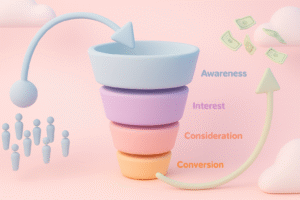In 2025, E-commerce is growing faster than ever. More people prefer online shopping nowadays to physical stores.
Digital commerce offers many opportunities for brands and businesses to boost their sales by selling online.
As the market grows quickly, startups face new challenges. They need to find ways to stand out, build a loyal customer base, and keep their sales steady in a crowded market.
If you want to run a successful online store, you must know how important it is to establish trust among customers, create smooth shopping experiences, and encourage buyers to return.
The best part is, you don’t need a big budget or complicated plans. With a few proven tips, you can start growing your sales sooner than you expect.
In this guide, we will share with you proven ways to increase E-commerce sales that help you build a successful and profitable business in 2025.
Whether you are a small startup or an established brand, these expert digital commerce success tips will help you out.
Understanding E-commerce Growth in 2025
The growth of e-commerce in 2025 is revolving around fast digital experiences, AI-driven personalization, and mobile-first shopping.
According to Shopify, global e-commerce sales are forecast to grow from $6.42 trillion in 2025 to $7.89 trillion by 2028.
This steady rise highlights how the e-commerce growth trends in 2025 will continue to shape the retail industry.
Many big brands are now using AI tools and data to understand customer preferences, enhance the buying journey, and deliver personalized product recommendations.
Customer behavior is also changing, as nowadays customers value speed, convenience, and a personalized experience.
They prefer fast checkout, mobile-friendly websites, and brands that remember their preferences.
To improve customer experience and to stay ahead in the competitive online marketplace, understanding these E-commerce trends 2025 and online shopping statistics will help businesses overcome the challenges.
How to Increase E-commerce Revenue: 10 Actionable Tips from Experts
The following are proven strategies for how to increase online sales:
Tip #1: Optimize Your Website for Conversions
Your website is the online storefront; it should be user-friendly, fast, and easy to use. According to research, if a page takes more than 3 seconds to load, over 50% of users leave.
That means that the website speed and overall user experience directly affect your sales.
Focus on website optimization techniques such as ensuring mobile responsiveness, reducing load times, and simplifying the checkout process to improve conversion rate optimization.
Implementing professional full-stack Shopify development can help achieve this, providing a seamless, fast, and fully optimized shopping experience.
To check what increases clicks, try A/B testing to compare different buttons, layouts, or images. Without additional ad spend, a well-optimized website can improve your online store experience and increase sales.
Tip #2: Leverage SEO to Drive Organic Traffic
To drive organic traffic to your store, E-commerce SEO is one of the most cost-effective ways.
Customers find you without paid ads when your product appears on the first page of Google.
Focus on using relevant keywords, writing original product descriptions, and adding internal links to help your website rank higher.
Instead of general ones, consider using long-tail product keywords such as “organic baby shampoo for sensitive skin”.
When you add structured data, search engines can better understand your product details, which makes your pages more visible.
For example, using the right keywords on product pages can lead to twice as much traffic in just a few months. Sticking with SEO over time helps your sales grow steadily.
Tip #3: Use Email Marketing for Customer Retention
For customer retention, email marketing is one of the highest-ROI tools. You can stay connected with your audience, send reminders about your products, and tailor offers to match what they like.
To boost engagement, you can send personalized recommendations, cart recovery emails, and offer seasonal campaigns.
For example, a small business can encourage customers to buy again by using basic email automation to send discounts to people who have shopped before. This simple gesture can help build loyalty and steady sales.
Tip #4: Leverage Social Media Marketing & Paid Ads
For building awareness and influencing buying decisions, social media platforms such as TikTok, Instagram, and Facebook are used. Social media platforms are the best E-commerce marketing strategies to implement.
A lot of people find out about new brands by watching short videos, reading reviews, or following influencer suggestions.
To get the best results from social media marketing and paid ads, try A/B testing, run retargeting campaigns, and work with influencers who share your brand values.
For example, when a skincare brand teams up with a beauty influencer, engagement can increase by as much as 30%. Combining creative ideas with smart planning can help your products reach more people.
Tip #5: Improve Product Descriptions & Visuals
Perfect product descriptions and high-quality images are the key to online sales. Good descriptions share your story, build trust, and encourage people to buy.
When you focus on clear and emotional benefits, customers feel more connected to your brand.
Use persuasive writing with compelling product photography and user-generated content such as customer photos or reviews.
One of the popular fashion brands reports that after featuring UGC on their product pages, their conversions increase by up to 25%. Nowadays, most people trust real experiences rather than polished ads.
Tip #6: Use E-commerce Marketplaces
You will need to build traffic from zero if you are starting your own website. However, E-commerce marketplaces offer the most convenient and seamless way to customers who are already looking for products like yours.
If you sell pet products, you can reach millions of pet owners who visit sites like Amazon every day.
If you sell private label or wholesale products, platforms like Tradewheel.com can help you connect with verified buyers around the world. Using these marketplaces makes it easier and faster to reach the right customers.
Tip #7: Simplify the Checkout Process
Many customers leave their carts behind when the checkout process is too complicated. In fact, cart abandonment rates can reach 70% worldwide.
People prefer a fast, easy way to buy, without extra steps.
To make the payment process easier, offer guest checkout and include multiple payment methods such as Apple Pay, PayPal, and credit cards.
Making your checkout process smoother and improving your online store’s user experience can help keep customers from leaving before they buy. This builds trust and leads to more completed purchases.
Tip #8: Using Google Analytics for E-commerce Success
To grow smartly, every E-commerce business should rely on analytics and data. Using E-commerce analytics helps you understand what’s working and which area needs improvement.
You can use tools such as Google Analytics, heatmaps, and CRM dashboards to learn more about how visitors interact with your site.
For example, if you track your conversion funnel, you might notice that many users leave before finishing checkout. This insight lets you address that specific step. Many brands using data-driven marketing gain access to better targeting and up to an 18% boost in ROI.
Tip #9: Invest in Excellent Customer Support
Customer support is the main factor that plays a crucial role in overall business performance. It can make or break your online business.
Responding quickly, offering live chat, and using helpful chatbots show customers you care. When people get the help they need right away, they often leave good reviews and come back to shop again.
Remember to focus on what happens after a customer makes a purchase. Following up after delivery or asking for feedback can help build stronger relationships.
Good customer support builds trust and makes it more likely that customers will buy from you again.
Tip #10: Optimize for Mobile Commerce
More than 70% of E-commerce traffic comes from mobile devices. If your website is not mobile-friendly, you could be missing out on customers.
Make sure your store works well on phones, loads quickly, and offers an easy checkout process.
Here’s a quick mobile optimization checklist:
- Use responsive layouts
- Test load time under 3 seconds
- Keep buttons large and easy to click.
- Enable auto-fill for forms.
- Simplify mobile checkout
When your mobile shopping experience works well, you’re more likely to see higher conversion rates.
Bonus Tip – Use AI tools for E-commerce Business Growth
In 2025, automation tools and AI are changing how E-commerce works. Technology helps you save time and scale smartly, from AI chatbots handling customer queries to predictive analytics forecasting sales trends.
For example, AI-powered product recommendations help boost sales by showing customers items they are likely to want.
E-commerce automation and AI tools also make your marketing efforts more efficient and tailored to each customer.
Common Mistakes to Avoid When Scaling E-commerce
| Mistake & Impact | Quick Fix |
| Ignoring Analytics – Missed insights on performance | Track KPIs and use data tools |
| Inconsistent Branding – Confuses customers | Maintain a consistent tone, color, and logo |
| Lack of Personalization – Low engagement and conversions | Use AI and email segmentation |
| Complicated Checkout – High cart abandonment | Simplify forms and add payment options |
| Neglecting Mobile Users – Lost traffic and sales | Optimize for mobile-first experience |
Conclusion
Growing an E-commerce business requires steady effort and smart planning. These 10 expert tips help you establish a successful E-commerce brand, from improving your website to using AI tools, that can help you increase sales and achieve lasting success.
Remember that E-commerce growth is not only about luck. It comes from having a clear strategy, staying consistent, and earning your customers’ trust.








